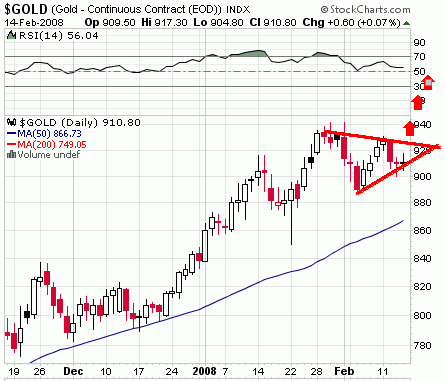
US Bonds: Safe Haven or Wealth-Cemetery?
You know the spiel. Every time the stock markets drop, the financial press reports that US treasuries benefited from the move in a “safe haven bid” - whatever that means.
Let’s examine how safe US treasuries really are:
- The 10-year notes and 30-year bonds are at multi-decade highs and show all signs of running out of steam from a purely technical perspective (Chart 1);
- Even the government’s price-inflation figures, carefully controlled and hedonistically calculated as they are to show only minimal inflation, are blowing out. Last year’s Labor Department wholesale inflation number was the highest in 26 years;
- There are huge international US treasuries overhangs languishing in foreign central banks. These CB’s (and sovereign wealth funds) are desperately looking for ways to reduce their holdings without causing a collapse in US bond prices;
- This foreign overhang is still rising because foreigners are trying to keep their value from collapsing. The expansion of the overhang shows no desire for abating anytime soon, yet - until the fire sale finally starts;
- The US Fed is taking that worry out of foreign holders’ hands. By having kept US rates artificially low for far too long, it has laid the groundwork for the current credit crunch that will turn into a headlong collapse when sovereign debt downgrades keep pouring in;
- Ratings agencies have artificially propped up sovereign and corporate debt ratings dues to their built-in conflict of interest in accepting payment for their services from the entities they rate. That tower is in the process of disintegrating;
- More and more of the money leaving the stock markets is either finding its way into precious metals instead of US treasuries, or it is staying in cash;
- US unfunded mandates were out of control under Bush and will be even more out of control under his successor (unless Ron Paul should win an unlikely upset victory during an independent run, that is). Moody's has already warned that the US sovereign credit rating is at risk for this reason.
Early signs of this coming collapse are already visible in the charts. The 30 year bond shows the beginning of a serious breakdown pattern after its recent blow-off top on January 23rd. The big black bar shows the apex of the most recent run-up since June of ‘07 when the subprime and credit crunch crisis hit. Now, these crises persist as the bond prices begin to fall.

Zooming back into time, it appears that the most recent top is part of a five-year triple-top that caps a 26-year bull run in US treasury long bonds.

Zooming forward in time from there, the three-month USB chart shows the fat black candlestick blow-off top in stark preeminence above what may look like the steeple top of an old-time graveyard church. I therefore took the liberty to insert the horizontal bar of the "cross" that will soon mark the grave of the US long bond - and the end to the artificially prolonged life span of below-market interest rates.

This most recent top confirms the forecast made in a previous article from December 10th, called
Nuclear Bond Implosion Ahead
The price for the long bond has now already lodged below the 50 day moving average (blue line). When it hits the red 200 day MA, things will start to unravel rather rapidly. Even sovereign wealth funds don’t like to hold onto stuff that rapidly loses value. They prefer to buy our productive assets or near-majority stakes in our financial institutions. That way, they don’t have to contend with US military power.
The more Bernie cuts, the higher inflationary expectations rise, the more bond investors will want to exit their bonds in favor of something that outpaces the dollar’s loss of purchasing power - and most people know very well what that is, even though they don't quite want to admit that to themselves yet.
Gold has kept up quite nicely throughout all of this turmoil - as expected. It has held up despite American and even Indian jewelry and scrap gold owners' turning in their metal for what they believe is a “windfall” in cash or stocks, or whatever.
“Wind” is probably the right term. The wind will blow their paper gains right out of the window. “Fall” is likely to be prophetic in a very poetic sense as well, as the real value of their desired paper gains will disappear into that great big hole in the ground called "inflation."
In fact, gold is currently consolidating above $900 and it is nearly at the end of its triangle formation. Another week at the most, and it will break out to the upside.

That coming push can easily take it through the $1000 level, where it will again consolidate before pushing higher. All you need to do to now why is to read the headlines and bylines of today’s MarketWatch email alert on the keyword “credit crunch”.It reads as follows:
Latest credit-market trap could hit closed-end funds
SAN FRANCISCO (MarketWatch) -- Auction-rate securities, the latest minefield in the credit market, may soon claim a new victim: closed-end funds. See full story.Citigroup fund bars exit by investors after bad bet
Citigroup Inc. has barred investors in one of its hedge funds from withdrawing their money, another black eye for the financial behemoth's troubled foray into new types of investments. See full story at WSJ.com (subscription required)
Spitzer warns bond insurers
The clock is running out for bond insurers to save their triple-A credit ratings. In congressional testimony yesterday, New York Gov. Eliot Spitzer gave a three-to-five-day time frame for the bond insurers to raise much-needed capital or find other ways to resolve their problems. See full story at WSJ.com (subscription required)
Banks at risk from $203 billion writedowns, says UBS
The world's banks ``remain at risk'' of up to $203 billion in additional writedowns, largely because the bond insurance crisis could worsen, UBS AG said. See full story at Bloomberg.com
Greenspan says U.S. economy is on edge of a recession
Former Federal Reserve Chairman Alan Greenspan said the U.S. economy is on the verge of its first recession in six years as falling home values hurt consumer spending. See full story at Bloomberg.com
Banks advised to walk away from big deals
Leading banks are being advised that it would be cheaper to walk away from big buy-out deals than incur further losses on their funding commitments, increasing the chances that more high-profile private equity transactions will collapse. This advice from lawyers contrasts with the conventional wisdom that banks would risk serious damage to their reputations if they were to drop out of deals. See full story at FT.com (registration required) End of Story
It doesn’t take much more than this to know where the financial world is headed: Back into gold and silver.
Got gold?
Alex Wallenwein
Editor, Publisher
The EURO VS DOLLAR MONITOR
Remove uncertainty from your investment outlook and gain the peace of mind that only Monitor Subscribers have in this financial chaos. Knowing ahead of time what to sell, when to sell it, and what to buy with the proceeds is crucial. Even more important is knowing when NOT to sell your most precious assets.
February 15, 2008
To stay up-to-date on important developments, sign up for our RSS Blog. It's FREE - and there are no email delivery problems!











